| dc.contributor.advisor | Eric Grimson. | en_US |
| dc.contributor.author | Schwarz, Omri | en_US |
| dc.contributor.other | Massachusetts Institute of Technology. Dept. of Electrical Engineering and Computer Science. | en_US |
| dc.date.accessioned | 2007-08-03T18:18:56Z | |
| dc.date.available | 2007-08-03T18:18:56Z | |
| dc.date.copyright | 2003 | en_US |
| dc.date.issued | 2006 | en_US |
| dc.identifier.uri | http://hdl.handle.net/1721.1/38245 | |
| dc.description | Thesis (M. Eng. and S.B.)--Massachusetts Institute of Technology, Dept. of Electrical Engineering and Computer Science, September 2006. | en_US |
| dc.description | Includes bibliographical references (p. 45-50). | en_US |
| dc.description.abstract | In this thesis, I designed and implemented a model of the electromagnetic signals generated by the human brain as seen on magnetoencephalography and electroencephalography machines. The model makes a novel use of the principle of reciprocity combined with Ohm's Law and the Biot Savart Law to build a model of the human magnetoencephalogram that is much faster to compute than the current state of the art. The model uses an existing finite difference model for electroencephalography and modifies it to incorporate the Bi6t Savart Law into its geometry. I tested the model against a spherical model to show that it is highly sensitive to approximations made of the Bi6t Savart Law for finite plane-bounded elements, but that further refinements of the model could make it as accurate as regular finite element models for magnetoencephalography. | en_US |
| dc.description.statementofresponsibility | by Omri Schwarz. | en_US |
| dc.format.extent | 50 p. | en_US |
| dc.language.iso | eng | en_US |
| dc.publisher | Massachusetts Institute of Technology | en_US |
| dc.rights | M.I.T. theses are protected by copyright. They may be viewed from this source for any purpose, but reproduction or distribution in any format is prohibited without written permission. See provided URL for inquiries about permission. | en_US |
| dc.rights.uri | http://dspace.mit.edu/handle/1721.1/7582 | |
| dc.subject | Electrical Engineering and Computer Science. | en_US |
| dc.title | A finite difference forward model for MEG and EEG | en_US |
| dc.type | Thesis | en_US |
| dc.description.degree | M.Eng.and S.B. | en_US |
| dc.contributor.department | Massachusetts Institute of Technology. Department of Electrical Engineering and Computer Science | |
| dc.identifier.oclc | 146521194 | en_US |
